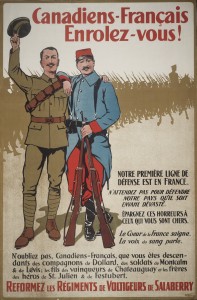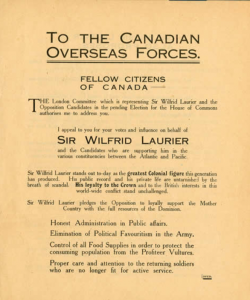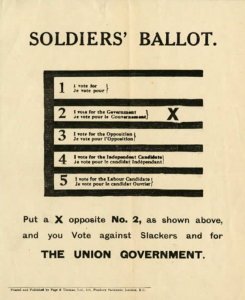[1] Opposition to conscription did not mean opposition to the war. In the February 1917, there had been a very successful campaign by the Patriotic Fund in Quebec to donate one day’s pay. Both Le Devoir and La Presse had donated space to support the campaign in the spirit of what was described as “bonne ententism”, and almost 2/3 of those who subscribed were French Canadians.
 At the same time it had become increasingly clear that volunteers alone could no longer meet the demand for reinforcements for the Canadian Corps. By April recruiting had fallen to 5,530, increasing only slightly in May with the news of the Canadian victory at Vimy Ridge. In that same battle, almost twice that number had been killed or wounded. Borden who had been in Britain with other Commonwealth leaders returned from a visit to troops in France convinced that conscription was the only solution.
At the same time it had become increasingly clear that volunteers alone could no longer meet the demand for reinforcements for the Canadian Corps. By April recruiting had fallen to 5,530, increasing only slightly in May with the news of the Canadian victory at Vimy Ridge. In that same battle, almost twice that number had been killed or wounded. Borden who had been in Britain with other Commonwealth leaders returned from a visit to troops in France convinced that conscription was the only solution.
Seeking to bolster support for conscription, Borden reached out to the opposition to form a union government. Laurier refused, fearing loss of his political base to Henri Bourassa, who led opposition to the war in Quebec. The Liberal party split over the issue with many liberals joining the union government to fight the election. In June, the Union government put forward legislation that would have enabled the government to conscript every male between 18 and 60.
Opposition to conscription was not limited to Quebec. Many farmers opposed the measure arguing that they needed their sons at home if they were to meet the rising demand for agricultural production. Labour leaders supported the conscription of wealth arguing that burden of service should be shared by the wealthy as well as the working class. Still others opposed the war as a matter of conscience or saw the measure as an offense against Canadian democracy. Among visible minorities denied political equality there was also objection to being called to serve in a nation that denied them equal rights with other citizens.[2] In Quebec however, the response was swift and dramatic.
As the conscription legislation moved forward under the Union government, Borden was forced to compromise. Exemptions were promised for farmers, their sons and conscientious objectors. The age range of those eligible was also narrowed. By late August, the Military Service Act was law, making all male citizens between 20 and 45 subject to military service for the duration of the war.
To bolster his support in the impending election, Borden introduced two major changes to election laws: the Military Voters Act and the Wartime Elections Act.
The Military Voters Act
 The Military Voters Act defined military voters as any active or retired member of the Canadian Armed Forces including for the first time women, Indians, and those under 21 years old. It allowed military voters to assign their vote to any riding in which they had normally been resident.
The Military Voters Act defined military voters as any active or retired member of the Canadian Armed Forces including for the first time women, Indians, and those under 21 years old. It allowed military voters to assign their vote to any riding in which they had normally been resident.
The most offensive element of the legislation was a provision that delayed the counting of the military vote until 31 days after the election. Where a riding had not been selected, the party chosen by the voter could assign the vote to the riding where it was most needed. Thus, military votes could be used to change the results in ridings where the margin of victory had been narrow.
The Wartime Elections Act
The second act served the dual purpose of increasing the number of supporters for conscription and reducing the numbers opposed. Spouses, widows, mother, sisters and daughters of anyone who was serving or had served became eligible to vote provided they met age, nationality and residency requirements. At the same time, the act denied the vote to conscientious objectors, those born in an enemy country who became naturalized citizens after 1902 or anyone convicted of an offense under the Military Service Act.
The Historical Debate
The historical debate over the 1917 election centred on two fundamental questions.
Was Opposition to Conscription Primarily a French-Canadian issue?
Historian Desmond Morton put it this way
“Plenty of Canadians had decided to resist recruiting appeals, but French-Canadian resistance, highlighted by Henri Bourassa and his newspaper, Le Devoir, became a sufficient explanation to many British Canadians for any shortage of military manpower. The failings of Canada’s resolutely unilingual militia organization were unknown or irrelevant to the majority of Canadians. So were arguments that Quebeckers were better employed growing food or manufacturing shells in Montreal’s burgeoning munitions factories.”
That popular characterization opposition as a French-Canadian issue was exacerbated by the heated environment of the election campaign. Laurier was denounced as a traitor and supporters denounced as cowards. Support for the Union government depicted as a vote against slackers. In contrast, the Laurier Liberals argued that a vote for Laurier was a vote for honest government, a rejection of political favoritism in the army and a promise to take care of returning soldiers. Despite long running support for conscription, the protestant denominational press condemned such intolerance and appealed for understanding and dialogue.
The overwhelming 153 to 82 Unionist majority tends to obscure the much less dramatic shift in the popular vote of less than 10% shift at the national level. In addition to an overwhelming majority in Quebec, the Laurier Liberals retained strong support in the Maritimes. In Ontario, the Union government won only three more seats that it had in 1911. Critically, the judicious use of the military vote may have swung the decision in favour of the government in as many as 14 ridings.
Was Conscription Necessary?
There is no doubt that at the time conscription was introduced, the prospects of allied victory were far from certain. Russia had collapsed, and the American troops had yet to arrive in strength. Much bitter fighting lay ahead and no one could have predicted an end of the war by November 1918. Had the war continued into 1919 the modest number of conscripts, dismissed by many as unimportant, would have become essential to maintain the strength of the Canadian Corps.
The numbers are compelling. Only 47,509 conscripts served overseas and perhaps half that number served at the front.[6] Of these, most would have been assigned to infantry units where the demand was greatest. Within these infantry battalions, new arrivals would serve in front-line rifle companies. In the Canadian Corps the strength of these rifle companies was only about 10,000 or less than half the total strength of the Corps.
What these figures also disguise is the impact that conscription had on the number of volunteers. For many, the choice was between being conscripted and tainted with public disapproval or becoming a heroic volunteer. We might speculate that an equivalent number of men were “encouraged” to volunteer late in the war because of the likelihood of conscription.
Taken together, it is not unreasonable to assume that by the end of the war 10-20% of the front line troops were either conscripts or volunteers motivated by the threat of conscription.
[1] See Tim Cook, The Madman and the Butcher: The sensational wars of Sam Hughes and General Arthur Currie, Penguin Books, Toronto 2010.
[2] James W. St. G. Walker, “Race and Recruitment in World War 1: Enlistment of Visible Minorities in the Canadian Expeditionary Force” in Canadian Historical Review, LXX, 1, 1989 https://web.viu.ca/davies/H355H.Cda.WWI/Race%20and%20Recruitment%20in%20World%20War%20One.pdf
[3] Desmond Morton, Fight or Pay: Soldier’s Families in the Great War, UBC Press, Vancouver, 2004.
[4] See Gordon L. Heath, “The Protestant Denominational Press and the Conscription Crisis in Canada 1917-1918” in CCHA Historical Studies, 78 (2012), 27-46.
[5] https://www.elections.ca/
[6] Col G.E.L Nicholson, The Canadian Expeditionary Force 1914-1919: Official History of the Canadian Army in the First World War, Queen’s Printer, Ottawa. 1962, 551.

